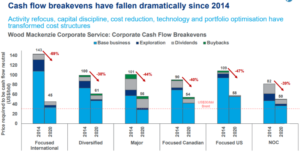Wood Mackenzie: Industry slashes spending as price rout deepens
Survival mode has returned to the oil and gas sector as the oil price rout deepens. Corporate financials are in better shape than during the 2014/2015 crash, but room for maneuvering is limited. Can companies cope with prices this low?
This crisis is very different from those that the sector has seen before. Debt and equity markets are all but closed for the US Independents, in contrast to the previous oil price collapse. Upstream M&A liquidity is also limited. Survival will rely on swift and deep cuts to investment.
Since the week of 9 March, more than a third of the companies Wood Mackenzie covers in its Corporate Service have cut CAPEX by 30%. More work will be needed if low prices linger.

“Deep spending cuts across the board are needed to achieve cash-flow neutrality at $35/bbl in 2020,” Roy Martin, from Wood Mackenzie’s Corporate Analysis Team, said. “We calculate an average spending cut of 57% will be required for our coverage if only upstream spend is targeted. A reduction of 41% would be needed across all spend categories, including dividends, to be cash flow neutral at $35/bbl.”
“Three companies (Occidental, Apache and Kosmos) have already cut their dividend, freeing up a combined $2.5 billion of capital,” Mr Martin added. “We expect more companies to follow suit. The Majors will use their balance sheets to support current dividends. We believe buybacks will be suspended and some will re-introduce scrip dividends to preserve cash.”
Mr Martin said more radical action may be needed if current low prices persist.
“Balancing the books at $30/bbl in 2020 is possible for many companies. But tough decisions would be required,” Mr Martin added. “Over $75 billion in 2020 discretionary E&D CAPEX and $80 billion of shareholder distributions to be cut – breaking a few promises to investors.”




